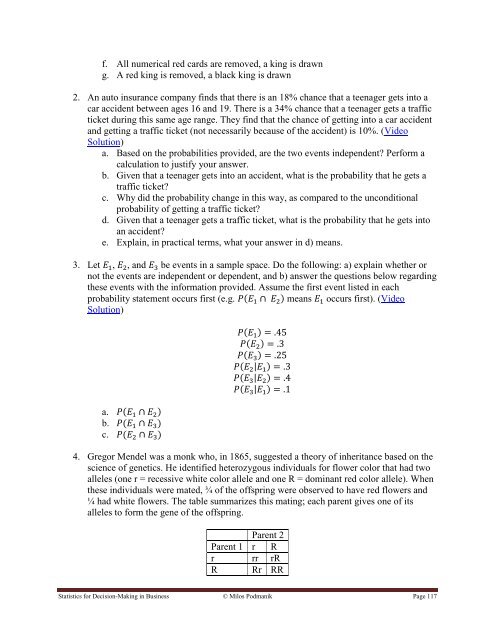Statistics for Decision- Making in Business - Maricopa Community ...
Statistics for Decision- Making in Business - Maricopa Community ...
Statistics for Decision- Making in Business - Maricopa Community ...
You also want an ePaper? Increase the reach of your titles
YUMPU automatically turns print PDFs into web optimized ePapers that Google loves.
f. All numerical red cards are removed, a k<strong>in</strong>g is drawn<br />
g. A red k<strong>in</strong>g is removed, a black k<strong>in</strong>g is drawn<br />
2. An auto <strong>in</strong>surance company f<strong>in</strong>ds that there is an 18% chance that a teenager gets <strong>in</strong>to a<br />
car accident between ages 16 and 19. There is a 34% chance that a teenager gets a traffic<br />
ticket dur<strong>in</strong>g this same age range. They f<strong>in</strong>d that the chance of gett<strong>in</strong>g <strong>in</strong>to a car accident<br />
and gett<strong>in</strong>g a traffic ticket (not necessarily because of the accident) is 10%. (Video<br />
Solution)<br />
a. Based on the probabilities provided, are the two events <strong>in</strong>dependent Per<strong>for</strong>m a<br />
calculation to justify your answer.<br />
b. Given that a teenager gets <strong>in</strong>to an accident, what is the probability that he gets a<br />
traffic ticket<br />
c. Why did the probability change <strong>in</strong> this way, as compared to the unconditional<br />
probability of gett<strong>in</strong>g a traffic ticket<br />
d. Given that a teenager gets a traffic ticket, what is the probability that he gets <strong>in</strong>to<br />
an accident<br />
e. Expla<strong>in</strong>, <strong>in</strong> practical terms, what your answer <strong>in</strong> d) means.<br />
3. Let , , and be events <strong>in</strong> a sample space. Do the follow<strong>in</strong>g: a) expla<strong>in</strong> whether or<br />
not the events are <strong>in</strong>dependent or dependent, and b) answer the questions below regard<strong>in</strong>g<br />
these events with the <strong>in</strong><strong>for</strong>mation provided. Assume the first event listed <strong>in</strong> each<br />
probability statement occurs first (e.g. ( ) means occurs first). (Video<br />
Solution)<br />
a. ( )<br />
b. ( )<br />
c. ( )<br />
( )<br />
( )<br />
( )<br />
( )<br />
( )<br />
( )<br />
4. Gregor Mendel was a monk who, <strong>in</strong> 1865, suggested a theory of <strong>in</strong>heritance based on the<br />
science of genetics. He identified heterozygous <strong>in</strong>dividuals <strong>for</strong> flower color that had two<br />
alleles (one r = recessive white color allele and one R = dom<strong>in</strong>ant red color allele). When<br />
these <strong>in</strong>dividuals were mated, ¾ of the offspr<strong>in</strong>g were observed to have red flowers and<br />
¼ had white flowers. The table summarizes this mat<strong>in</strong>g; each parent gives one of its<br />
alleles to <strong>for</strong>m the gene of the offspr<strong>in</strong>g.<br />
Parent 2<br />
Parent 1 r R<br />
r rr rR<br />
R Rr RR<br />
<strong>Statistics</strong> <strong>for</strong> <strong>Decision</strong>-<strong>Mak<strong>in</strong>g</strong> <strong>in</strong> Bus<strong>in</strong>ess © Milos Podmanik Page 117
















